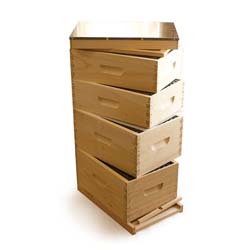There are a couple of ways to directly observe varroa mites to see if your hives are infected. It’s important to note that observational methods aren’t accurate population counts of mites, but rather further proof your hive has an issue.
- Screen bottom boards – when bees groom each other, sometimes they find varroa mites and bite them loose from each other, allowing the mite to fall to the bottom of the hive. If you have a screen bottom board in place with a sticky board beneath it, it can allow you to see these fallen mites. Place the sticky board in place for a certain amount of time (e.g. 24 hours) before examining them. This can be a messy practice, as a lot of things fall to the bottom of hives over time.
- Common disease signs – varroa mites spread several diseases, all of which displaying varying symptoms in both adult bees and brood. Common symptoms include deformed wings, short abdomens, scattered brood, crippled and crawling honeybees, impaired flight performance, sunken and chewed cappings, and larvae slumped in the bottom or side of the cell.
- Site identification of mites – you can watch your bees up close (maybe even use a magnifying glass) to try to spot any varroa mites physically on them. Unfortunately, once you’re at this point, you likely have a bad infestation.
- Supersedure – honeybees supersedure for several reasons, so a supersedure doesn’t always mean a varroa mite infestation, but high mite loads can cause a supersedure.
